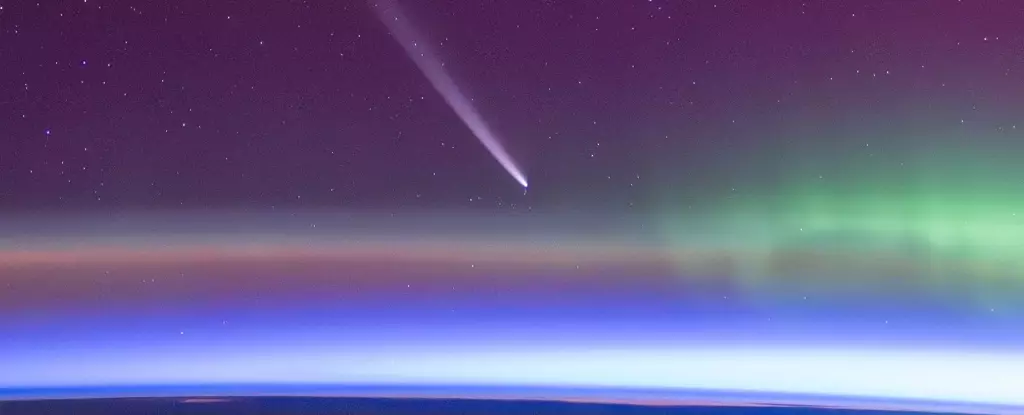The vastness of the universe can often be mind-boggling, and one of its most intriguing components is the Oort Cloud. This theoretical structure envelops our solar system, extending trillions of miles into the abyss of space. Although no telescope has directly imaged the Oort Cloud, astronomers hypothesize its existence due to indirect evidence, such as the behavior of long-period comets that visit us sporadically. The cloud forms an invisible shell consisting of billions of icy bodies, which remain tantalizingly out of sight but might hold the key to understanding both the origins of our solar system and the potential threats it harbors.
Every so often, we are graced by the appearance of comets—spectacular celestial events that ignite curiosity and wonder among both scientists and amateur stargazers alike. Two remarkable comets are set to transit near Earth this October: Tsuchinshan-ATLAS (C/2023 A3) and C/2024 S1 (ATLAS). What’s particularly thrilling about these comets is their visibility; Tsuchinshan-ATLAS will be observable shortly after sunset in the western sky starting around October 12, while C/2024 S1 will rise in the eastern sky as dawn approaches.
Their arrival not only captivates viewers but also serves as a reminder of the unresolved mysteries surrounding the Oort Cloud, where these comets are believed to originate. The existence of such a cloud is vital for explaining why comets with long orbital periods can travel immense distances that stretch far beyond our solar system’s inner regions.
The Oort Cloud is theorized to contain around 100 billion icy objects, potentially rivaling the number of stars in our Milky Way galaxy. These icy bodies likely formed near the gas giant Jupiter before being nudged into far-flung orbits by gravitational interactions. The Oort Cloud is split into two sections: the inner Oort Cloud, which is denser, and the outer region, that extends far into interstellar space. Long-period comets can take thousands or even millions of years to complete their journey around the Sun, resulting in unpredictable appearances that pose both scientific intrigue and existential risk.
While the potential for these comets to collide with Earth is minuscule, the introduction of new comets into our vicinity can have dire implications. Their massive orbits can easily be perturbed by the gravitational influence of surrounding stars, resulting in paths that bring them dangerously close to our planet.
Though the statistical chances of a comet impacting Earth are extremely low, the unpredictability of long-period comets represents a unique challenge for planetary scientists. Movies like “Don’t Look Up” sensationalize these risks, yet the prospect is one that scientists take seriously. For instance, the recent DART (Double Asteroid Redirection Test) mission has illustrated that we can, with sufficient warning, redirect an asteroid’s path. Unfortunately, the same foresight may not be available for comets, given their sudden and unexpected approaches.
Past endeavors, such as the discovery of ‘Oumuamua in 2017, demonstrate the urgency of improving our ability to observe and analyze these celestial visitors. Although ‘Oumuamua is classified as an interstellar object and not specifically from the Oort Cloud, its sudden arrival emphasizes an unsettling reality: we may have limited time to react if one of these icy bodies were to head toward Earth.
To prepare for the unknown threats posed by Oort Cloud comets, ongoing research is essential. Determining the extensive characteristics of these comets—such as size, trajectory, and composition—will empower scientists with better predictive capabilities. The advent of advanced observational tools, including the upcoming Legacy Survey of Space and Time conducted at the Rubin Observatory, is expected to help double the catalogue of known Oort Cloud comets.
Moreover, the European Space Agency’s Comet Interceptor mission, set to launch in 2029, aims to position a probe into space with the goal of intercepting an Oort Cloud comet and studying it in real-time. Such projects could offer groundbreaking insights into the fundamental materials that composed our solar system during its nascent stages billions of years ago.
As we gear up for the participation of the imminent comets Tsuchinshan-ATLAS and C/2024 S1, a sense of wonder accompanies their appearance in the night sky. Fortunately, these comets will pass at a safe distance from Earth, serving instead as shimmering reminders of the mysteries that lie just beyond our planetary cradle. The natural allure of astronomy lies not only in the beauty of these celestial events but also in the unfolding story of our cosmic neighborhood and the ancient traditions held within the enigmatic Oort Cloud.

